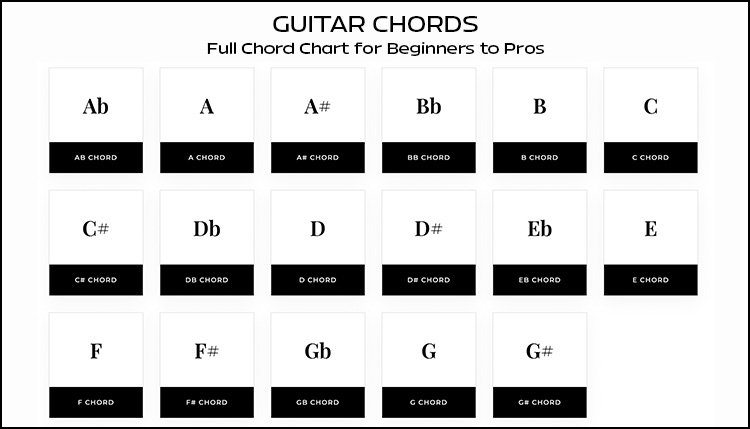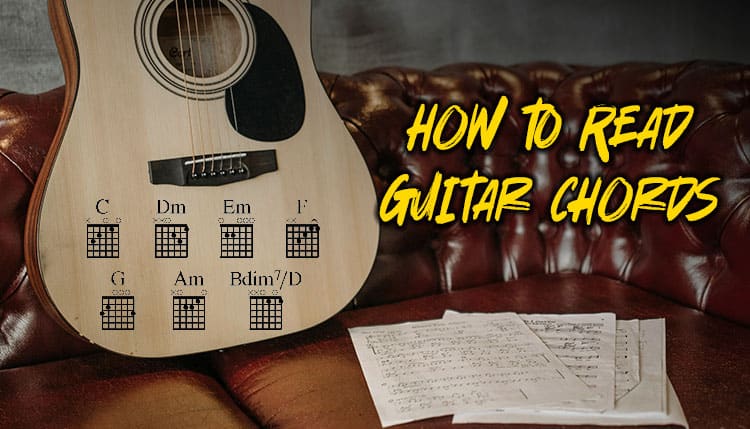Why You Should Learn Guitar Chords First
Grasping guitar chords is like finding the musical key to every song you love.
Once you know a handful of shapes—major, minor, power chords—you’ll unlock thousands of riffs, ballads, and rock anthems.
Plus, building a strong chord vocabulary sets you up for more advanced techniques (fingerpicking, solos, jazz voicings) down the road.
How to Read Guitar Chord Diagrams
Chord diagrams are your roadmap:
- vertical lines = strings (E–A–D–G–B–E left to right)
- horizontal lines = frets (the top thick line is the nut)
1. Dots & Finger Numbers
Dots mark where to press. Numbers inside dots indicate fingers:
| Finger | Number |
|---|---|
| Index | 1 |
| Middle | 2 |
| Ring | 3 |
| Pinky | 4 |
| Thumb | T |
2. Open vs. Muted Strings
- O above a string → play it open.
- X above a string → mute it (don’t strum).
3. Fret Numbers
If a diagram shows “3fr,” start counting frets from the third fret. Otherwise, assume it begins at fret one.
Open Chords vs. Barre Chords
| Chord Type | Description | Examples |
|---|---|---|
| Open | Some strings ring freely “open.” | C, G, D, A, E |
| Barre | One finger presses all strings at once. | F, Bm, F#m |
Open chords sound warm and are perfect for beginners. Barre chords take practice but let you move chord shapes up and down the neck to change key instantly.
Major, Minor & Power Chords at a Glance
- Major (happy, bright): root + major third + perfect fifth.
- Minor (moody, soulful): root + minor third + perfect fifth.
- Power chords (rock staples): root + fifth (sometimes octave), easy to move and punchy.
Quick-Start Chord Shapes
C Major
- Index → 1st fret, B string
- Middle → 2nd fret, D string
- Ring → 3rd fret, A string
Strum starting from the 5th string.
G Major
- Middle → 3rd fret, low E string
- Index → 2nd fret, A string
- Ring → 3rd fret, B string
- Pinky → 3rd fret, high E string
Strum all six strings.
F Major (barre)
- Index → barre all at 1st fret
- Middle → 2nd fret, G string
- Ring & Pinky → 3rd fret, A & D strings
Strum all six strings.
Tip: Always keep your thumb at the back of the neck and fingertips perpendicular to the fretboard for clean notes.
Building Smooth Transitions
- Practice slowly. Get each finger in place before speeding up.
- Keep fingers close to the fretboard to minimize movement.
- Use a metronome to lock in timing—start at 60 BPM, then gradually increase your tempo.
Essential Beginner Exercises
| Exercise | Chords | Pattern |
|---|---|---|
| Chord Jam | A → D → E | 4 strums each |
| G–C–D Shuffle | G → C → D | 4 strums each |
| E–F Toggle | E → F | 4 strums each |
Loop each sequence for 3–5 minutes, focusing on clean changes.
Overcoming Common Challenges
Finger Pain & Calluses
- Short daily practice (10–15 min) builds calluses naturally.
- Press just hard enough for a clear tone—overpressing leads to fatigue.
Stretching Difficult Shapes
Warm up with a “spider” exercise:
- → 1st finger on 1st fret low E
- → 2nd on 2nd fret A
- → 3rd on 3rd fret D
- → 4th on 4th fret G
- Then shift up one fret
Capo Hacks
Place a guitar capo to simplify barre chords—e.g., capo on 3rd fret lets you play G shapes in B♭.
Advanced Tips: Chord Progressions & Voicings
Common progressions:
- I–IV–V (C–F–G)
- ii–V–I (Dm–G–C)
- I–vi–IV–V (C–Am–F–G)
Alternate voicings give fresh colors:
- C: x32010 → x35553
- G: 320003 → 355433
Peek ahead in your chart so you’re ready for the next shape, and listen for rhythmic cues in the strumming pattern.
Tech Tools to Speed Your Learning
- Apps: Yousician, Guitar Tricks, Fender Play (iOS & Android).
- Websites: Ultimate Guitar for tabs; JustinGuitar & Marty Music for video lessons.
- Tuners: GuitarTuna, Fender Tune, PolyTune (all free options).
Next Steps
- Learn one new chord per day—track progress in a practice journal.
- Record yourself to catch buzzing strings or timing issues.
- Jam along with simple backing tracks on YouTube.
Frequently Asked Questions
How to read guitar chords?
To read guitar chords, use a chord diagram that shows strings vertically and frets horizontally. Dots indicate finger placement, and “X” or “O” shows whether to mute or play an open string.
How to play guitar chords?
To play a guitar chord, press the correct strings on the right frets using your fingers and strum all or specific strings as shown in the chord diagram.
How many guitar chords are there?
There are thousands of guitar chords, but most songs use around 8–15 basic chords. These include major, minor, 7th, and variations like barre chords and jazz extensions.
How many chords should a beginner learn?
Start with 5–7 open chords (C, G, D, A, E, Am, Em). They appear in countless songs.
When can I switch to barre chords?
Once you’re comfortable changing open chords cleanly (around 4–6 weeks), gradually introduce an F or Bm shape.


